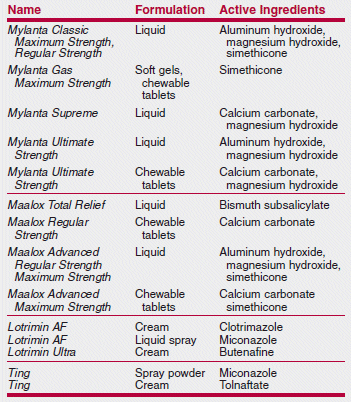Matching articles for "OTC drugs"
In Brief: Only The Name Remains The Same
The Medical Letter on Drugs and Therapeutics • June 28, 2010; (Issue 1341)
A Medical Letter subscriber was surprised to discover that a new Citracal product contained not only calcium citrate, but also calcium carbonate. Citracal Plus Bone Density Builder actually contains more...
A Medical Letter subscriber was surprised to discover that a new Citracal product contained not only calcium citrate, but also calcium carbonate. Citracal Plus Bone Density Builder actually contains more calcium carbonate per tablet than calcium citrate (240 mg vs. 60 mg). Another Citracal product, Citracal Plus Heart Health, also contains more calcium carbonate than calcium citrate. Many clinicians prefer calcium citrate because it can be taken with or without food, while calcium carbonate must be taken with food for optimal absorption. Other familiar over-the-counter (OTC) names also contain some surprises among their ingredients, as shown in the table below.

>Many well-known brand-name OTC products no longer contain only or necessarily any of their original ingredients.
Download: U.S. English
Treatment of Peptic Ulcers and GERD
The Medical Letter on Drugs and Therapeutics • August 1, 2008; (Issue 72)
Peptic ulcers caused by treatment with nonsteroidal anti-inflammatory drugs (NSAIDs) are mainly gastric ulcers. Most duodenal and other gastric ulcers are caused by the gram-negative bacillus Helicobacter...
Peptic ulcers caused by treatment with nonsteroidal anti-inflammatory drugs (NSAIDs) are mainly gastric ulcers. Most duodenal and other gastric ulcers are caused by the gram-negative bacillus Helicobacter pylori. Gastroesophageal reflux disease (GERD) is caused by gastric acid reflux into the esophagus. Drugs that suppress gastric acid production are the primary treatment for GERD and peptic ulcers.
In Brief: Cetirizine OTC
The Medical Letter on Drugs and Therapeutics • January 14, 2008; (Issue 1277)
Cetirizine (Zyrtec, and others) and cetirizine/pseudoephedrine (Zyrtec-D) are becoming available without a prescription this month for treatment of allergic rhinitis and urticaria in adults and children....
Cetirizine (Zyrtec, and others) and cetirizine/pseudoephedrine (Zyrtec-D) are becoming available without a prescription this month for treatment of allergic rhinitis and urticaria in adults and children. Cetirizine is the second of the second-generation H1-antihistamines to become available over the counter. Loratadine (Claritin, and others) was the first.
Cetirizine has been shown to be more effective than loratadine in suppressing histamine-induced wheals in healthy volunteers (W Carey et al. Drugs Exp Clin Res 2002; 28:243), but no well-controlled clinical trials have established that any second-generation H1-antihistamine is more effective overall than any other (M Plaut and MD Valentine. N Engl J Med 2005; 353:1934).
Cetirizine may be mildly sedating in some patients, but it is significantly less sedating than first-generation H1-antihistamines such as diphenhydramine (Benadryl, and others) or chlorpheniramine (Chlor-Trimeton, and others), which have been available without a prescription for many years. Its safety in young children is better documented than that of any other first- or second-generation H1-antihistamine (Treat Guidel Med Lett 2007; 5:71).
Download U.S. English
Cetirizine has been shown to be more effective than loratadine in suppressing histamine-induced wheals in healthy volunteers (W Carey et al. Drugs Exp Clin Res 2002; 28:243), but no well-controlled clinical trials have established that any second-generation H1-antihistamine is more effective overall than any other (M Plaut and MD Valentine. N Engl J Med 2005; 353:1934).
Cetirizine may be mildly sedating in some patients, but it is significantly less sedating than first-generation H1-antihistamines such as diphenhydramine (Benadryl, and others) or chlorpheniramine (Chlor-Trimeton, and others), which have been available without a prescription for many years. Its safety in young children is better documented than that of any other first- or second-generation H1-antihistamine (Treat Guidel Med Lett 2007; 5:71).
Download U.S. English
